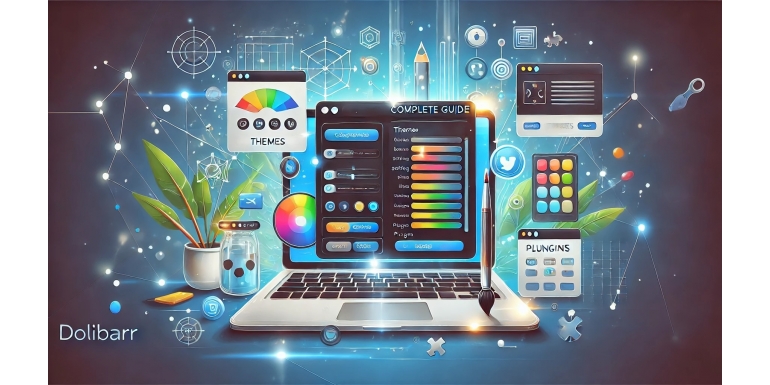
Introduction
Dolibarr is a widely adopted open-source ERP and CRM solution used by businesses and freelancers to manage their activities. Thanks to its modular architecture, it offers great flexibility, allowing users to adapt it to their specific needs with themes and plugins.
In this article, we will explore in detail how to customize Dolibarr using themes to enhance its appearance and plugins to expand its functionality. Whether you are a beginner or an advanced user, this guide will help you optimize your Dolibarr experience.
1. Why Customize Dolibarr?
Dolibarr is designed to be modular and extensible, meaning you can configure it according to your specific needs. Customizing Dolibarr allows you to:
-
Improve ergonomics: A well-designed theme can make the interface more intuitive and pleasant to use.
-
Add new functionalities: Plugins make it possible to add tools specific to your business.
-
Boost productivity: A well-organized workspace makes information access easier and optimizes management time.
-
Adapt the tool to your branding: Changing Dolibarr’s appearance allows you to better reflect your company’s image.
2. Customizing with Themes
2.1. What is a Dolibarr Theme?
A Dolibarr theme is a set of CSS and graphic files that modify the visual appearance of the user interface. Installing a theme allows you to change colors, fonts, icons, and the layout of on-screen elements.
2.2. Where to Find Dolibarr Themes?
Several sources offer compatible themes for Dolibarr:
-
Dolistore: The official store for Dolibarr modules and themes.
-
GitHub and GitLab: Some developers provide their themes as open-source projects.
-
Third-party sites: Some providers offer premium themes with dedicated support.
2.3. Installing a Dolibarr Theme
Installing a theme typically involves the following steps:
-
Download the theme file (usually a compressed .zip folder).
-
Extract the file and copy the theme folder into the
htdocs/theme/directory of Dolibarr. -
Access the Dolibarr admin interface.
-
Go to Configuration > Display and select the installed theme.
-
Save changes and refresh the page.
2.4. The Best Themes for Dolibarr
Here are some popular themes:
-
MD Theme: A modern and clean theme with an improved interface.
-
ELDY Dark: A dark version of the default theme, ideal for reducing eye strain.
-
AdminLTE for Dolibarr: Provides a more intuitive user interface with a responsive design.
3. Customizing with Plugins
3.1. What is a Dolibarr Plugin?
A Dolibarr plugin (or module) is an extension that adds new features to Dolibarr. These plugins help enhance client management, product tracking, invoicing, and much more.
3.2. Where to Find Dolibarr Plugins?
As with themes, plugins can be found on:
-
Dolistore: The official store containing a wide variety of modules.
-
Open-source platforms like GitHub.
-
Third-party developers who create custom solutions for businesses.
3.3. Installing a Dolibarr Plugin
To install a plugin, follow these steps:
-
Download the module file (.zip or .tgz).
-
Extract and copy the module folder into
htdocs/custom/. -
Go to Configuration > Modules/Applications.
-
Locate and activate the module.
-
Configure the module according to your business needs.
3.4. The Best Plugins for Dolibarr
Here are some must-have modules to optimize Dolibarr:
-
Advanced CRM Module: For improved client and sales opportunity management.
-
Project Management Module: Helps manage tasks and track project progress.
-
Advanced Invoicing Module: Adds extra features to automate financial management.
-
E-commerce Module: Synchronization with platforms like WooCommerce or PrestaShop.
4. Tips for Optimizing Customization
4.1. Choosing Compatible Themes and Plugins
Before installing a theme or plugin, ensure that it is compatible with your Dolibarr version. Check user reviews and available updates.
4.2. Test Before Deployment
If you use Dolibarr for critical operations, it is advisable to test new themes and plugins in a staging environment before deploying them in production.
4.3. Avoid Excessive Customization
Too many plugins or modifications can slow down your Dolibarr instance. Keep only the tools that add real value.
4.4. Perform Regular Updates
Developers regularly release updates to improve performance and fix security vulnerabilities. Ensure your themes and plugins are always up to date.
Conclusion
Customizing Dolibarr with suitable themes and plugins is an excellent way to optimize your work environment. Whether for better ergonomics, smoother management, or advanced automation, numerous tools are available to meet your needs.
By following this guide, you will be able to choose and install the right extensions to make Dolibarr an even more powerful and tailored tool for your business. Feel free to experiment with different options and share your experience with the Dolibarr community!
